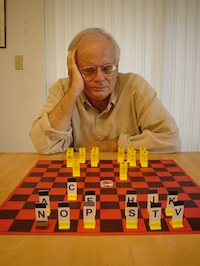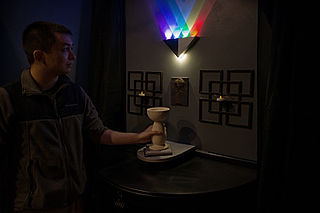
In Greek mythology, the Labyrinth was an elaborate, confusing structure designed and built by the legendary artificer Daedalus for King Minos of Crete at Knossos. Its function was to hold the Minotaur, the monster eventually killed by the hero Theseus. Daedalus had so cunningly made the Labyrinth that he could barely escape it after he built it.

In Greek mythology, the Minotaur is a mythical creature portrayed during classical antiquity with the head and tail of a bull and the body of a man or, as described by Roman poet Ovid, a being "part man and part bull". He dwelt at the center of the Labyrinth, which was an elaborate maze-like construction designed by the architect Daedalus and his son Icarus, on the command of King Minos of Crete. The Minotaur was eventually killed by the Athenian hero Theseus.
Recreational mathematics is mathematics carried out for recreation (entertainment) rather than as a strictly research and application-based professional activity or as a part of a student's formal education. Although it is not necessarily limited to being an endeavor for amateurs, many topics in this field require no knowledge of advanced mathematics. Recreational mathematics involves mathematical puzzles and games, often appealing to children and untrained adults, inspiring their further study of the subject.

Theseus was the mythical king and founder-hero of Athens. The myths surrounding Theseus – his journeys, exploits, and friends – have provided material for fiction throughout the ages.

In Greek mythology, Ariadne was a Cretan princess and the daughter of King Minos of Crete. There are different variations of Ariadne's myth, but she is known for helping Theseus escape the Minotaur and being abandoned by him on the island of Naxos. There, Dionysus saw Ariadne sleeping, fell in love with her, and later married her. Many versions of the myth recount Dionysus throwing Ariadne's jeweled crown into the sky to create a constellation, the Corona Borealis.
A puzzle is a game, problem, or toy that tests a person's ingenuity or knowledge. In a puzzle, the solver is expected to put pieces together in a logical way, in order to arrive at the correct or fun solution of the puzzle. There are different genres of puzzles, such as crossword puzzles, word-search puzzles, number puzzles, relational puzzles, and logic puzzles. The academic study of puzzles is called enigmatology.
A logic puzzle is a puzzle deriving from the mathematical field of deduction.
Programming paradigms are a way to classify programming languages based on their features. Languages can be classified into multiple paradigms.

Nonograms, also known as Hanjie, Paint by Numbers, Picross, Griddlers, and Pic-a-Pix, and by various other names, are picture logic puzzles in which cells in a grid must be colored or left blank according to numbers at the side of the grid to reveal a hidden pixel art-like picture. In this puzzle type, the numbers are a form of discrete tomography that measures how many unbroken lines of filled-in squares there are in any given row or column. For example, a clue of "4 8 3" would mean there are sets of four, eight, and three filled squares, in that order, with at least one blank square between successive sets.

Eleusis is a shedding-type card game where one player chooses a secret rule to determine which cards can be played on top of others, and the other players attempt to determine the rule using inductive logic.

Robot Odyssey is a programming game developed by Mike Wallace and Dr. Leslie Grimm and published by The Learning Company in December 1984. It was released for the Apple II, TRS-80 Color Computer, and MS-DOS. Most players have found it challenging. The player is readying for bed when, suddenly, they fall through the floor into an underground city of robots, Robotropolis. The player begins in the sewers of the city with three programmable robots, and must make their way to the top of the city to try to find their way home again.

Robert Abbott was an American game inventor, sometimes referred to by fans as "The Official Grand Old Man of Card Games". Though early in his life he worked as a computer programmer with the IBM 360 assembly language, he began designing games in the 1950s.

Theseus and the Minotaur is a type of logic maze designed by Robert Abbott. In this maze, the player acts as Theseus, the king of Athens who is attempting to escape the Labyrinth. The main difference between this and the standard type of labyrinth, beyond the fact that it is set on a grid, is the fact that the maze is not empty, but also contains a Minotaur who hunts the player down, taking two steps for every one the player takes.
Nikoli Co., Ltd. is a Japanese publisher that specializes in games and, especially, logic puzzles. Nikoli is also the nickname of a quarterly magazine issued by the company in Tokyo. Nikoli was established in 1980 and became prominent worldwide with the popularity of Sudoku.

A picture maze is a maze puzzle designed to resemble something visually, or one where the solution traces out a particular picture.

Super Solvers: Gizmos & Gadgets is an educational science video game designed by The Learning Company. It is intended to teach children between the ages of 7 and 12 introductory mechanics, namely simple machines, magnets, basic electronics, and forms of energy. The original game is compatible with computers running DOS 3.3 or higher and a later CD release added Windows 95 and Macintosh compatibility. A popular game through 1997, The Learning Company, then incorporated with Broderbund, discontinued Gizmos & Gadgets in 1998. Riverdeep eventually obtained the rights and re-released it in some of the "Adventure Workshop" collections.
Ariadne's thread, named for the legend of Ariadne, is solving a problem by multiple means—such as a physical maze, a logic puzzle, or an ethical dilemma—through an exhaustive application of logic to all available routes. It is the particular method used that is able to follow completely through to trace steps or take point by point a series of found truths in a contingent, ordered search that reaches an end position. This process can take the form of a mental record, a physical marking, or even a philosophical debate; it is the process itself that assumes the name.

Castle of Dr. Brain is an educational video game released in 1991 by Sierra On-Line. It is a puzzle adventure game.

Steve Ryan is an American author who specializes in the creation of games and puzzles. Ryan is also a television game show historian and creator. Ryan was a long-standing staff member of Goodson-Todman Productions and Mark Goodson Productions, where he created the concept for the game show Blockbusters. Ryan also created the rebus puzzles for the game show Classic Concentration. He was also a writer and creator of puzzles for the game shows Body Language, Catch Phrase, Password Plus and Trivia Trap.

An escape room, also known as an escape game, puzzle room, exit game, or riddle room is a game in which a team of players discover clues, solve puzzles, and accomplish tasks in one or more rooms in order to accomplish a specific goal in a limited amount of time. The goal is often to escape from the site of the game. Most escape games are cooperative but competitive variants exist. Escape rooms became popular in North America, Europe, and East Asia in the 2010s. Permanent escape rooms in fixed locations were first opened in Asia and followed later in Hungary, Serbia, Australia, New Zealand, Russia, and South America.















